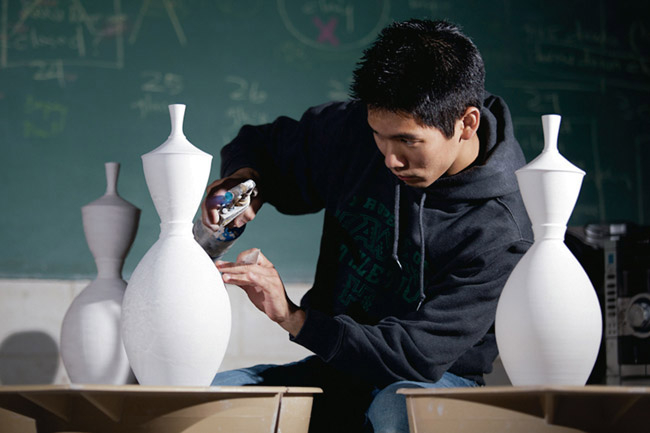Reveling in Clay
If you happen to be in Waikiki, stroll into the Waikiki Parc lobby and you’ll see the result of UH ceramics student Dustin Miyakawa’s kneading and shaping, firing and caressing. Seven cylindrical vessels stand tall and stately in his pottery exhibit Aquatic Amphoric. To hear the gusto with which Miyakawa describes his work, these are seven exquisite examples of petrified passion.
art_1
“My first love was throwing (forming clay on a wheel),” he says. “There’s something fascinating about the way clay moves on the wheel. It’s no longer a static object – form seems to be born out of motion.”
He first stumbled, quite literally, into pottery-making when as an Iolani elementary school student he happened upon an art instructor throwing a huge vase. Right then he decided to pursue ceramics, and he’s been going at it for 12 years now. There’s nothing unique about his work, and he’s quick to point out why:
“I am continuing a ceramic tradition that references classical Asian forms. Contemporary art is deeply rooted in history and craft. My main aim is to accentuate these relationships, not their differences.”
His pieces at the Parc are American-style raku, an adaptation of traditional Japanese techniques developed over the past century. Miyakawa’s work is influenced by the aesthetic of renowned local ceramic artist Jeff Chang. Miyakawa makes cups, bowls, vases, “then sometimes I’ll get amped and have a crushing urge to throw unnecessarily large, pompous things that take up too much space in the studio. It’s pretty ridiculous,” he laughs. “But I will never, ever make anything with a handle, or anything off the wheel. I am a pure thrower.”
His Parc show, Aquatic Amphoric, an ode to channel markers that guide ships to and from harbor, finds a parallel in its placement along the corridor wall, guiding people to and from their rooms. An amphora is a tall, ancient Greco-Roman ceramic vessel with a narrow neck, used for carrying both dry products and liquids. Miyakawa’s exhibit charts that space between solid and fluid, ancient and modern, East and West.
Look for his next big show in April at UH’s main Art Gallery. The installation will feature his hugely ambitious BFA capstone project, featuring ceramic vessels using materials he sourced himself from areas of the continental U.S. known for their significant mining and ceramic art traditions. Also a photographer, Miyakawa will have photos on display documenting his travels.
the TICKET stub
AQUATIC AMPHORIC
When: Through Jan. 4
Where: Waikiki Parc
More Info:facebook.com/waikikiparc
ALSO SHOWING
50 Years of Art
Twigs, driftwood, fiber and found organic material shaped into honu, a dolphin, mermaid, whale and more make up artist Mark Jacobsen’s contemporary work – he calls the form “assemblage.” He’s also been painting, drawing, doing sculptures and collage for half a century. An assortment of recent work and older pieces will be featured in his exhibit, Recent & Retrospective at Loading Zone (47 N. Hotel St., Load-ingZoneArts.com). It opens First Friday Dec. 7 (6-11 p.m.) and will run through Dec. 28, with a reception Dec. 15 from 3 to 6 p.m.
Among his 15 or so pieces on display, some are quite large. His assemblage creations are known to stretch 10 feet or more. When asked if there’s any common thread connecting his work, he shies away from any thematic pigeonholing.
“If there is a thematic element,” he says, “I suppose it would be that of playfulness and experimentation.”
He takes his playfulness seriously, positing the question, “Why is it that musicians are said to ‘play’ while artists ‘work’?” Like musicians dabble in various musical genres, Jacobsen plays with a range of mediums and styles. His latest works find him at play with nature.






